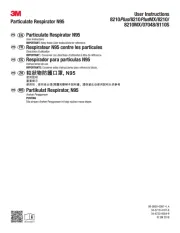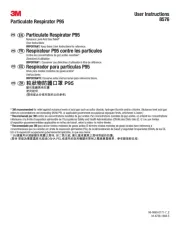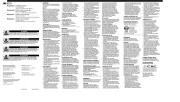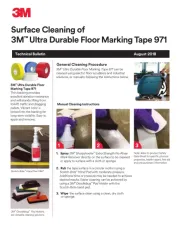3M Peltor X5A Handleiding
3M
Niet gecategoriseerd
Peltor X5A
Bekijk gratis de handleiding van 3M Peltor X5A (1 pagina’s), behorend tot de categorie Niet gecategoriseerd. Deze gids werd als nuttig beoordeeld door 8 mensen en kreeg gemiddeld 4.4 sterren uit 4.5 reviews. Heb je een vraag over 3M Peltor X5A of wil je andere gebruikers van dit product iets vragen? Stel een vraag
Pagina 1/1

United States Canada
Technical Service 1 800 243-4630 Technical Service 1 800 267-4414
Sales Assistance 1 800 896-4223 Sales Assistance 1 800 265-1840 ext. 6137
G12
2000 Resource Guide
Hearing Protection
G
Education
How to Use
the Noise
Reduction
Rating (NRR)
The NRR describes the average
sound level reduction (attenuation)
provided by a hearing protection
device (HPD) in a laboratory test.
Since the NRR is based on
laboratory testing, it does not take
into account the loss of protection
that occurs when hearing protectors
are not fit properly or when they are
not worn for the entire time that the
wearer is exposed to noise
For most wearers, the NRR
identified on the current EPA label
(shown here) significantly
overestimates the protection of the
hearing protector in the workplace.
This rating is based on an
“experimenter fit” method of
measuring HPD attenuation.
Using the EPA Noise Reduction
Rating (Experimenter Fit)
The NRR on the EPA label
shown to the right is based on the
average amount of attenuation
provided by an HPD when it is
worn by 10 different people during
a laboratory test. During this test,
the person conducting the test fits
the hearing protector on each
person. This “experimenter fit”
method results in ratings as high as
33 dB. Since research indicates
that these ratings overestimate the
protection that many wearers will
receive in the real world, 3M
RECOMMENDS REDUCING
THE NRR before attempting to
estimate the effectiveness of an
HPD as follows:
1. Subtract 7 dB from the NRR if
noise is measured on the A-
weighted decibel scale (dBA).
(Skip this step if noise is measured
on the C-weighted dB scale)
2. Divide the result of step 1 (NRR-
7) by 2. This is known as
“derating”.
A New Rating: NRR (SF)
A new “subject fit” method of
measuring HPD attenuation will be
used in the future to calculate a
different rating; the NRR (SF). The
people (subjects) in this laboratory
test fit their own protector according
to the manufacturer’s instructions
without the help of the person
conducting the test. Compared to
the NRR shown on the current EPA
label, the NRR (SF) is usually a
lower rating that may be closer to the
performance of the hearing protector
An Example of Reducing the NRR
8-hour TWA noise exposure: 93 dBA
NRR of hearing protectors: 29 dB
Subtract 7 dB from the NRR: 29 dB - 7 dB = 22 dB
Divide by 2: 22 ÷ 2 = 11 dB
Subtract 11 dB from the
8-hour TWA noise exposure: 93 dBA - 11 dB = 82 dB
Decide if 82 dB (known as the “Protected Exposure”)
is below the PEL for noise
in the real world. For more
information about the NRR (SF),
contact 3M Technical Service at
800 243-4630.
Estimating Noise Reduction for
Individual Users
The labeled values of noise
reduction are
based on
laboratory
tests. It is not
possible to
use these data
to reliably
predict levels
of protection
achieved by a
given
individual in
a particular
environment.
To ensure
protection, those wearing hearing
protectors for occupational
exposures must be enrolled in a
hearing conservation program. Non-
occupational users should have a
hearing evaluation by an audiologist,
physician, or other qualified
professional, on a regular basis.
Product specificaties
| Merk: | 3M |
| Categorie: | Niet gecategoriseerd |
| Model: | Peltor X5A |
| Kleur van het product: | Zwart |
| Certificering: | CE |
| Draagwijze: | Hoofdband |
| Beste gebruik: | Construction, High noise environment, Machine operations |
| Dempingswaarden (SNR): | 37 dB |
Heb je hulp nodig?
Als je hulp nodig hebt met 3M Peltor X5A stel dan hieronder een vraag en andere gebruikers zullen je antwoorden
Handleiding Niet gecategoriseerd 3M

11 Juni 2025

10 Juni 2025

10 Juni 2025

25 Februari 2025

17 Mei 2024

1 December 2023

20 Mei 2023

14 Mei 2023

7 Mei 2023

26 April 2023
Handleiding Niet gecategoriseerd
- MIFAB
- UDG Gear
- OVIDE
- BSS Audio
- IPGARD
- Blumfeldt
- Makita
- Prido
- Mimo Monitors
- iBOLT
- AEG
- Finnlo
- Simrad
- Nec
- Sôlt
Nieuwste handleidingen voor Niet gecategoriseerd

14 September 2025

13 September 2025

13 September 2025

13 September 2025

13 September 2025

13 September 2025

13 September 2025

13 September 2025

13 September 2025

13 September 2025